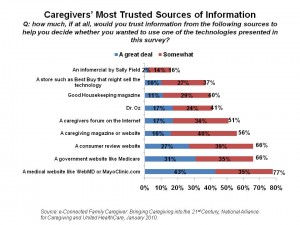![]() Caregivers identify the most helpful technologies that benefit them in providing care to family and friends as personal health record tracking, medication support, caregiving coordination, and monitoring and transmitting symptoms. These technologies are seen to help caregivers save time, make caregiving logistically easier, make the care recipient feel safer, reduce stress and enhance feelings of being effective.
Caregivers identify the most helpful technologies that benefit them in providing care to family and friends as personal health record tracking, medication support, caregiving coordination, and monitoring and transmitting symptoms. These technologies are seen to help caregivers save time, make caregiving logistically easier, make the care recipient feel safer, reduce stress and enhance feelings of being effective.
The most formidable obstacle preventing caregivers from adopting beneficial technologies is cost, followed by the technology not addressing the caregiver’s most pressing challenges, care recipient resistance to using the device, privacy issues, diminishing the care recipient’s sense of independence and pride.
The National Alliance for Caregiving (NAC) assessed the utility of and barriers to using 12 technologies that support caregivers in their processes of providing care to family and friends. Results of NAC’s survey are analyzed in the report, e-Connected Family Caregiver: Bringing Caregiving into the 21st Century. This study coincides with the 2011 Consumer Electronics Show in Las Vegas which featured summits on both SilverSurfers and Digital Health.
The caregiver sampled surveyed by NAC already use some sort of technology in their caregiving processes such as searching the internet for support and services. 7 in 10 of these caregivers would be receptive to using smartphone apps to assist with caregiving.
Stress is a huge risk for caregivers: 3 in 4 caregivers believe that technologies could reduce stress, increase feelings of being effective, help logistically and save them time. At the same time, technologies also have benefits for people being cared-for — from feeling safer to being more independent and connected to others.
The survey was conducted on behalf of the National Alliance for Caregiving, funded by UnitedHealthcare, fielded in November 2010. Matthew Greenwald & Associates conducted an online survey among 1,000 technology-using caregivers 18 years of age and older. These caregivers provided at least 5 hours per week of unpaid care to an adult relative or friend who needed help due to a physical or mental illness, disability or frailty. The caregiver had also used some sort of technology to help them with caregiving, e.g., searching for caregiving information on the internet, participating in an online forum, using an electronic calendar, etc.
 Health Populi’s Hot Points: Caregiving requires a high degree of health engagement and advocate-activation. A precursor to health engagement is trust, so it was smart for NAC to gauge caregivers’ trust-levels for various sources of information on health and caregiving. These sources are shown in the chart, led by medical websites like WebMD and MayoClinic.com, government websites like CMS.gov, and consumer review websites. One-half of caregivers also trust caregivers forums online — echoing the finding that patients like other “People Like Me” found in previous consumer health surveys. Social networks for caregivers, offline and on-, are powerful on many levels: for collegiality, of course, but also to learn best practices, helpful tips, and clinical information that has worked with peer-caregivers and their families.
Health Populi’s Hot Points: Caregiving requires a high degree of health engagement and advocate-activation. A precursor to health engagement is trust, so it was smart for NAC to gauge caregivers’ trust-levels for various sources of information on health and caregiving. These sources are shown in the chart, led by medical websites like WebMD and MayoClinic.com, government websites like CMS.gov, and consumer review websites. One-half of caregivers also trust caregivers forums online — echoing the finding that patients like other “People Like Me” found in previous consumer health surveys. Social networks for caregivers, offline and on-, are powerful on many levels: for collegiality, of course, but also to learn best practices, helpful tips, and clinical information that has worked with peer-caregivers and their families.
What’s also intriguing in this chart is that Dr. Oz and Good Housekeeping are virtually tied in caregivers’ levels of trust. One of these sources is relatively new to the scene — Dr. Oz joined Oprah on television for the first time in 2004. Good Housekeeping has been around since 1885, over a century before Dr. Oz became the health expert on Team Oprah.
Trust is an enabler and a barrier. Cost is another one: note that Best Buy is embraced trust-wise by nearly 1 in 4 caregivers. Remember that this sample includes only caregivers using technology, and Best Buy is a trusted market channel for consumer electronics. As more health goes retail in the eyes and pocketbooks of consumers, Best Buy and other retail channels will become important and valued health destinations for people seeking greater health engagement for themselves and their loved ones. Read more about this phenomenon in Health Populi’s post, That’s Dr. Geek Squad to You.




 I'm in amazing company here with other #digitalhealth innovators, thinkers and doers. Thank you to Cristian Cortez Fernandez and Zallud for this recognition; I'm grateful.
I'm in amazing company here with other #digitalhealth innovators, thinkers and doers. Thank you to Cristian Cortez Fernandez and Zallud for this recognition; I'm grateful. Jane was named as a member of the AHIP 2024 Advisory Board, joining some valued colleagues to prepare for the challenges and opportunities facing health plans, systems, and other industry stakeholders.
Jane was named as a member of the AHIP 2024 Advisory Board, joining some valued colleagues to prepare for the challenges and opportunities facing health plans, systems, and other industry stakeholders.  Join Jane at AHIP's annual meeting in Las Vegas: I'll be speaking, moderating a panel, and providing thought leadership on health consumers and bolstering equity, empowerment, and self-care.
Join Jane at AHIP's annual meeting in Las Vegas: I'll be speaking, moderating a panel, and providing thought leadership on health consumers and bolstering equity, empowerment, and self-care.